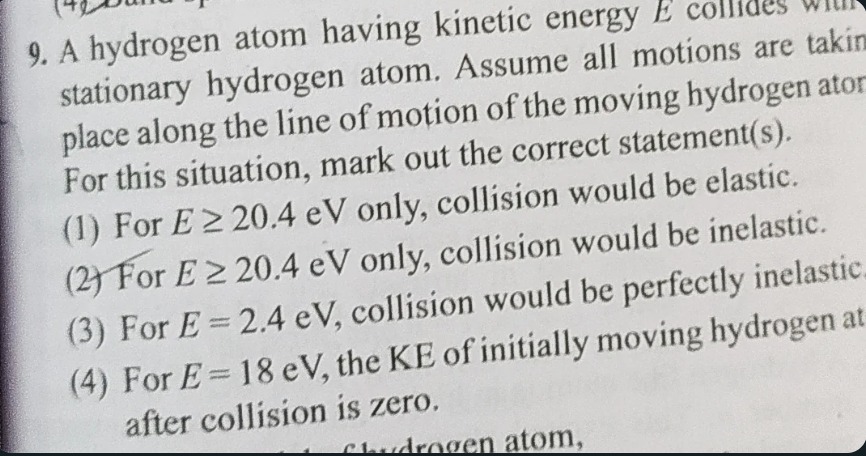Question
Question: A hydrogen atom having kinetic energy E collides with a stationary hydrogen atom. Assume all motions...
A hydrogen atom having kinetic energy E collides with a stationary hydrogen atom. Assume all motions are taking place along the line of motion of the moving hydrogen atom.
For this situation, mark out the correct statement(s).

For E≥20.4 eV only, collision would be elastic.
For E≥20.4 eV only, collision would be inelastic.
For E=2.4 eV, collision would be perfectly inelastic.
For E=18 eV, the KE of initially moving hydrogen atom after collision is zero.
For E=18 eV, the KE of initially moving hydrogen atom after collision is zero.
Solution
Let m be the mass of a hydrogen atom. The initial kinetic energy of the moving hydrogen atom is E=21mv02, where v0 is its initial velocity. The stationary hydrogen atom has initial kinetic energy 0. The collision is happening along the line of motion, so it's a head-on collision.
We need to consider the energy levels of the hydrogen atom. The ground state energy is E1=−13.6 eV. The first excited state energy is E2=−3.4 eV. The minimum energy required to excite a hydrogen atom from the ground state is ΔEmin=E2−E1=−3.4−(−13.6)=10.2 eV.
For a collision to be inelastic, some kinetic energy must be converted into internal energy (excitation or ionization). This requires the initial kinetic energy available in the center of mass (CM) frame to be at least equal to the minimum energy required for the internal energy change. The initial kinetic energy in the CM frame is KCM,i=21μvrel2, where μ=m+mm⋅m=2m is the reduced mass and vrel=v0−0=v0 is the relative velocity. KCM,i=212mv02=41mv02=21(21mv02)=2E. For an inelastic collision to be possible, KCM,i≥ΔEmin.
2E≥10.2 eV
E≥20.4 eV.
- If E<20.4 eV, then KCM,i<10.2 eV. Since the minimum internal energy change is 10.2 eV, no internal energy change can occur. The collision must be elastic.
- If E≥20.4 eV, then KCM,i≥10.2 eV. An inelastic collision is possible (e.g., one atom gets excited). An elastic collision is also possible (no internal energy change).
Let's evaluate the given options:
(1) For E≥20.4 eV only, collision would be elastic.
This is false. For E<20.4 eV, the collision must be elastic. For E≥20.4 eV, the collision can be elastic or inelastic.
(2) For E≥20.4 eV only, collision would be inelastic.
This is false. For E<20.4 eV, the collision must be elastic. For E≥20.4 eV, the collision can be inelastic, but it is not necessarily inelastic (it can be elastic).
(3) For E=2.4 eV, collision would be perfectly inelastic.
If E=2.4 eV, then E<20.4 eV. The collision must be elastic. A perfectly inelastic collision is a type of inelastic collision. So, this statement is false.
(4) For E=18 eV, the KE of initially moving hydrogen atom after collision is zero.
If E=18 eV, then E<20.4 eV. The collision must be elastic.
In a head-on elastic collision between two identical particles (mass m), one initially moving with velocity v0 and the other stationary, conservation of momentum and kinetic energy gives:
mv0+m⋅0=mv1′+mv2′
21mv02+21m⋅02=21mv1′2+21mv2′2
Simplifying, we get:
v0=v1′+v2′
v02=v1′2+v2′2
Substituting v0=v1′+v2′ into the second equation:
(v1′+v2′)2=v1′2+v2′2
v1′2+2v1′v2′+v2′2=v1′2+v2′2
2v1′v2′=0
This implies either v1′=0 or v2′=0.
If v2′=0, then v1′=v0, which means the moving atom passes through the stationary one without interaction, which is not a collision.
The physical solution for a collision is v1′=0, which implies v2′=v0. The initially moving atom stops, and the stationary atom moves with the initial velocity of the first atom.
Thus, for a head-on elastic collision between identical particles with one initially stationary, the final kinetic energy of the initially moving particle is zero.
Since for E=18 eV the collision is elastic and head-on, the kinetic energy of the initially moving hydrogen atom after collision is zero. Statement (4) is correct.
